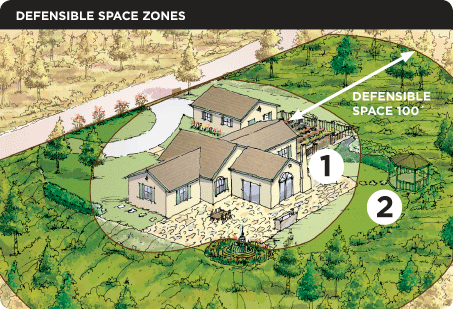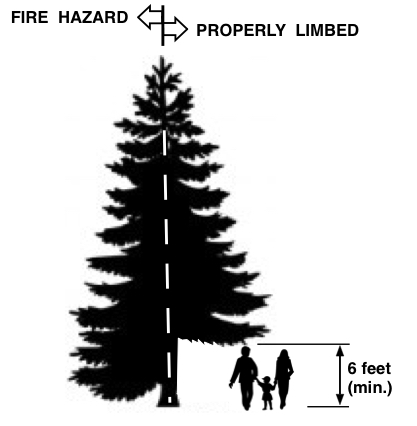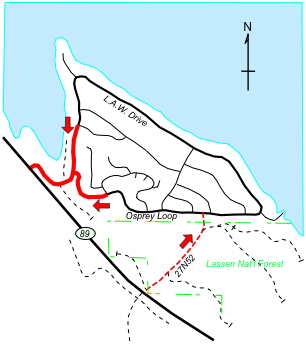GOOD PRACTICES
This lengthy page contains overviews of topics that are important to maintaining a Firewise home and community. Further information can also be found in materials noted on the "Resources" page.
- Defensible Space
- Tree Limbing
- Debris Disposal
- Staying Prepared
- Emergency Procedures
Defensible Space
California law (Public Resources Code 4291) requires that we maintain a minimum area of "defensible space" around all structures. That area extends outward one hundred (100) feet from structures or to the property line, whichever is less. This means that we are required to remove natural debris such as pine needles, leaves, down branches, dead brush, dry weeds or dry grass in that zone. We also must remove manmade debris accumulations, such as construction scraps and just plain trash from that area, and we must take steps to eliminate continuous fuel paths between natural vegetation on the parcel (e.g., tree to tree, brush to brush, or brush to tree).
The nearest several feet of area immediately adjacent to structures, sometimes called the "home ignition zone", should be completely free of all combustibles. The first thirty (30) feet (area "1" in the illustration below) needs very careful attention to ensure that fire cannot spread either horizontally or vertically. The remaining seventy (70) feet of the defensible space zone (area "2"), out to a total of one hundred (100) feet or the property line, must also be cleaned up but has a bit more latitude when it comes to well maintained trees and shrubs. Considerably more information on defensible space is found on the CalFire webpage noted in the "Resources" page.

Each year CalFire conducts inspections of developed parcels to ensure that homeowners are abiding by state law, and WACC inspects undeveloped lots for compliance with CC&Rs. Undeveloped lots must be kept free of dead, dying, down or diseased vegetation, trees must be limbed up (see next section), and debris must be removed, basically as if it were in "Zone 2" of the Defensible Space criteria. If you should receive a notice from CalFire or WACC regarding a need for remedial action, please deal with the issue promptly.
Please be aware that insurance carriers may impose even more stringent thinning and cleanup requirements as a condition of offering or renewing fire insurance.
Tree Limbing
One of the most important fire safety practices involves the removal of lower tree limbs to reduce the risk of a surface fire getting into tree crowns. Local CC&Rs require that this be done on ALL trees on ALL residential lots. On small trees (less than 18 feet tall), the lower 1/3 of the branches should be removed. On larger trees, remove any branch that comes within six (6) feet of the surface. You should be able to walk under your trees without having to duck your head. An even larger gap is recommended on very large trees. Brush or shrubs should not be under trees.

Debris Disposal
Keeping our yards fire safe means that we need to dispose of combustible debris that comes from trees, brush and other natural sources. Conifer needles, leaves, twigs, limbs and pieces of dead brush tend to accumulate faster than we would prefer, and they all need to be removed. The safest and most environmentally friendly means of disposal is by hauling the debris to a local cogeneration plant (currently not available here), by chipping the material and using it as mulch, or by hauling it to a green waste disposal site.
State law also permits residents to dispose of small quantities of natural yard debris by burning it during certain (low hazard) times of the year. Those allowable burn periods are announced by local fire officials, who will also identify related burning restrictions such as allowable times of day, etc. Air quality issues also come into play, and burning may only occur on permissive burn days. Always check with the Fire Chief regarding current information on burn restrictions, and with AQMD regarding permissive burn days, BEFORE you light a burn pile.
Basic Burning Restrictions
WHEN burning is allowed, there are some fundamental restrictions that ALWAYS apply, including:
- No burn barrels may be used in Plumas County.
- Fires may only be lit on permissive burn days. Always call AQMD at (530) 258-2588, extension 5, to verify.
- Only natural debris may be burned. You may NOT burn garbage, plastics, tires, oily substances, tar paper, construction debris, etc.
- Only a small (4 ft. by 4 ft.) pile may be burning at a time. You can add to that pile as it burns down.
- Fires must be attended by a responsible adult at all times, and proper tools and water must be immediately available on site.
- Fires should only be lit when winds will not cause a problem.
- Before leaving the fire, it must be COMPLETELY extinguished. This means that the ash is cold to the touch.
Remember that if your fire escapes and causes damage, you can be held personally responsible for the damages.
Burn Permits
Burning small accumulations of natural debris that result from ordinary residential yard cleanup activity require a burn permit during parts of the year (often from the 1st of May to the end of allowable burning in late June). These permits are issued free of charge by CalFire using an online connection. Large accumulations of debris from lot clearing, timber cutting or non-residential activity require a specific (commercial) burn permit issued by the Northern Sierra Air Quality Management District in Quincy; a fee is charged for such permits.
Smoke
Smoke is the result of incomplete combustion of the material being burned. In the case of natural yard debris, a fire that continues to produce heavy smoke after being ignited typically means that the material is too green, too wet, too compressed or contains too much dirt to burn properly. When such smoke stays near the ground and drifts around the neighborhood it creates a public nuisance and a health hazard.
Both Plumas County and the Northern Sierra AQMD have regulations in place requiring that residential burning be conducted in a manner that produces a minimum amount of smoke. This means that all debris must be DRY (a minimum of 30 days of drying time for light materials and even longer for heavy branches). A burn pile most also be kept loose and free of dirt so that air can circulate freely to promote a hot fire and complete combustion. Trying to burn green, damp or compacted debris will only produce clouds of dense smoke.
County regulations require that "Burning shall be curtailed when smoke is drifting into a nearby populated area or creating a public nuisance." If your burning creates continued heavy smoke, you need to put the fire out. Otherwise your neighbors have every right to complain to the Quincy AQMD office and you could end up being cited. So remember, you can minimize smoke by:
- Burning thoroughly DRY materials
- Keeping the pile SMALL and LOOSE.
Staying Prepared
In spite of all attempts to keep wildland fire at a distance, there is always the possibility of fire approaching the development, meaning that evacuation is a distinct possibility. Each household should create its own evacuation checklist and departure plan, tailored to its own family circumstances and needs. Ignoring or postponing this important step simply means that when an emergency occurs you will be at a serious disadvantage.
Emergency Procedures
In addition to preparing an evacuation checklist, it is recommended that residents familiarize themselves with the basics of neighborhood emergency procedures. None of us are anxious to face an emergency, but having knowledge of local practices beforehand will help us respond promptly and without panic.
Individual Emergencies
Whenever there is a situation where you need medical, fire or law enforcement assistance, call 9 1 1 . Tell the dispatcher what the emergency is and provide the location. "Land line" (wired) phones should automatically display the address of the caller to the dispatcher, but cell phones do not; if you are using a cell phone you will need to provide the address or location to the dispatcher. If there is a hazardous situation at a residence, such as a fire or the smell of gas, GET OUT PROMPTLY.



